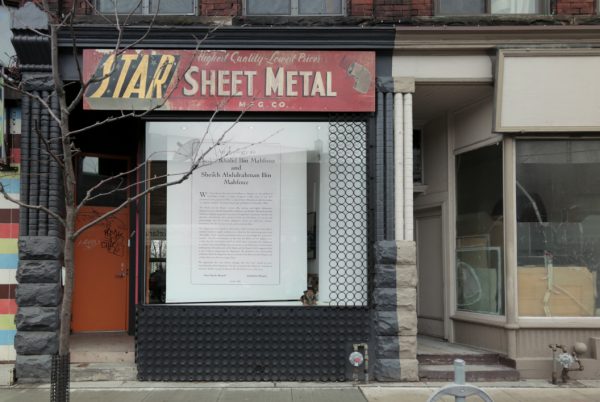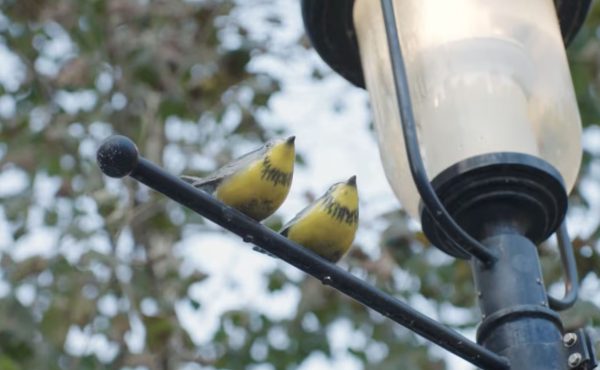
Public Studio is the Toronto-based collective art practice of filmmaker and artist Elle Flanders and architect and artist Tamira Sawatzky. Since 2009, Public Studio has employed a diverse range of media resulting in large-scale public art works, films, immersive installations, lens-based works and socially engaged projects. Their work explores antagonisms that occur in and around the disappearance of public space, while engaging topics such as political dissent, surveillance and ecology.
Until July 30, Public Studio is currently installed at the Art Gallery of Ontario, as the artist-in-residence, where they are conducting research in preparation for walking the length of the Bruce Trail over several months in 2017. The Bruce Trail is a 900 kilometre hiking trail in southern and central Ontario that follows the edge of the Niagara Escarpment. It is one of 13 UNESCO World Biosphere Reserves in Canada and is maintained by over 1,400 volunteers. As part of their residency, Public Studio invites you to participate in their journey by adding to their 8-foot high trail map, currently on display in the Community Gallery.
Q: As artists working across various media, both within and outside of institutional contexts, your way of working challenges the very definition of what it means to create “public art”. Can you comment on your understanding of the practice and what it means to be public artists?
Elle Flanders: I guess our first response would be a question back to you: What definition of “public art” are you working from?
As far as our own practice goes, as an architect-filmmaker-artist team, we devised Public Studio as a place to bring our practices into conversation with one another and to enlarge that by working with other artists and thinkers in a variety of fields, which also includes working with communities. It combines our philosophical outlook, our way of being in the world together with our work. As an architect, Tamira has been engaged with questions of public space and how to address public space as part of her daily considerations; as a political activist, my concerns are rooted in social justice and how bodies and voices in public space function.
Our practice considers what German artist Joseph Beuys called “the enlarged conception of art”, which is to suggest that we work from an understanding that art can organize life. But institutional frames continue to press art into corners that separate it from public life and being “public artists” becomes a pejorative. Because the space in which most art circulates is the vast art market, it too becomes segregated and hence is seen as separate from “public art” or public life for that matter. Our work attempts to bridge these gaps and put art back into public discourse and to treat life as art, or at least thinking about aesthetics as an organizing tool.

Q: You are currently conducting research in preparation for walking the Bruce Trail in 2017. Why is this trail of interest?
Tamira Sawatzky: Elle and I have done a lot of work in the Middle East, that’s where our practice really began. Elle had previously done a lot of work around land politics and Israel and Palestine, and I joined her in that practice. We did many projects there and at a certain point, while Elle was very much invested in the landscape and politics, I realized that while I was concerned too, that the primal connection to where you are from was missing for me. I thought that we could look at those issues here in Canada, turning our gaze back homeward, where we now live.
EF: Part of that turn came when we were preparing for our recent Art Gallery of York University show What we lose in Metrics (2016) and despite looking at Canadian landscapes far and wide, it became obvious that the landscape we were most interested in, was the one right in front of us. Ontario seemed so unknown to me.
TS: I think it’s also a kind of radical intervention in our practice. We’re very urban people; we don’t go camping, so for us to commit to two months outside of city feels extreme. And I think we’re interested in pushing ourselves and seeing what comes out of that.
Q: What has been your most startling discovery to date?
TS: We are very interested in history, and are very aware of how constructed the Trail is. It was “old white guy naturalists” who put it together and unpacking that history will be interesting.
EF: I wouldn’t say “startling” at this point, as we are still in early research phases, but the Geology of the escarpment is interesting. We’ve begun to start thinking about history and time in much longer stretches. As contemporary artists it’s easy to get wrapped up in the here and now, and/or recent history. All too often in Canada we think of history as it relates to settlement, and if you’re politically conscious and articulating a decolonizing position, we speak about it in terms of indigenous life. Mostly we think in terms of human inhabitation. But what’s before that? What is the record here of “deep time”? How did the escarpment come to be the dominant, constant feature of this landscape?
One of the most interesting features of the Bruce Trail is the fact that it’s such a unique mix of public and private space. If we want to walk the Bruce Trail in one go, the question of how and where do you stay becomes vital. Some people will let you camp, but in many places you can’t, so where and how do you go? Who actually owns this space? We have this very public access route, well publicized, that cuts across a lot of private and government land, through which we are encouraged only to keep moving. The idea that this space is intended only to be “moved through” is a key feature – What does it mean to have so-called public space?
Q: The practice of walking isn’t new to contemporary art. What about it attracts you?
EF: The idea of walking and conceptualizing the body in space are important to us – we come up with many our projects through walking. As an architect, Tamira reminds me constantly of the importance of space. In our last show, in a traditional gallery, she was reminding me how space is, in and of itself, a form for us to use. Walking is also a political form — of knowing the land and of being on it with others.
TS: I think we’re craving something slower, and something visceral. The car isolates you from the landscape and you move through it quickly, in a cinematic fashion, whereas walking is visceral – you experience storms and feel the earth under your feet and listen to birds. I think that sounds romantic, but is actually quite real.
Q: In the AGO’s community gallery, you have installed a large series of maps of the Bruce Trail and are inviting the public to add to them with stickers. Why? How will this engagement further your research?
TS: We try to visualize information and that map of the Bruce Trail is our starting point. If our residency was longer, I think that map would grow even denser and richer, but our projects always take a really long time. The intention is to really layer on to the map that is in the community gallery, our research and ideas for what this project will become.
EF: Having the community engaged is part of what we do, is part of our social practice. Each project is different – some are more socially engaged than others. Because it is called a community gallery and there are so many kids running around here all the time, we chose to engage the community by asking them to think about the practice of walking. We hope the stickers and the map will encourage the public to take a minute, to pause and think about where they’ve been on the Trail and what they’ve seen. It will be interesting for us to integrate this cumulative knowledge into ours and see where it fits.
TS: It also fits in with our notion of collaboration. We often work with other artists, it is very important to us. In this case, I think our collaborator is the larger audience of the AGO.
Q: Your recent exhibition at AGYU, What we lose in Metrics cast a cold look at capitalism’s efforts to quantify our interactions with nature. Is your plan to hike the Bruce trail a response in some way to those attempts? Is nature a knowable other or should we be content to leave it alone?
TS: This question is at the heart of what we are exploring right now. At the AGYU we looked at how humans inhabit the forest, and concluded that there’s no real way for us to do that except through clearing and creating architecture. We don’t, at least in the western world, live in trees. And a necessity of inhabiting the forest is first clearing it. I think our Bruce Trail project is a response to the questions raised at the AGYU show, in the sense that the trail, is not about habitation but temporary passage, this movement through the woods for a specific time and what that means.
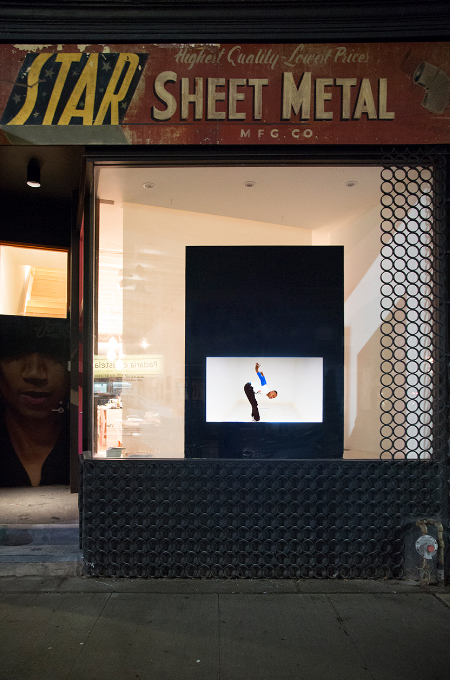
Q: Your ongoing project Public Window is a 24-hour street-facing exhibition space housed in the front window of your home. What has it taught you about the way we see public and private space differently? Or do we?
TS: Since we moved to Dundas St., we’ve had to adjust our expectations of private living. We have become more public by virtue of living in a storefront. And when we bought it, we never wanted to close up the store front and live behind that, as though it were a regular single family home. I believe we needed to give back to the street in someway. The way that made sense to us was as an exhibition space. We don’t curate it ourselves and we don’t show our own work, rather we invite others to. It’s about the world outside of us and it has become an interstitial place, somewhere between private and public. Our home in turn has become a series of graduated spaces that become more private the deeper you go in. If we have dinner parties in the front, it feels like we’re at a restaurant. But of course, there are consequences.
I also think we’ve learned to be more hospitable, people wave and drop by much more often.
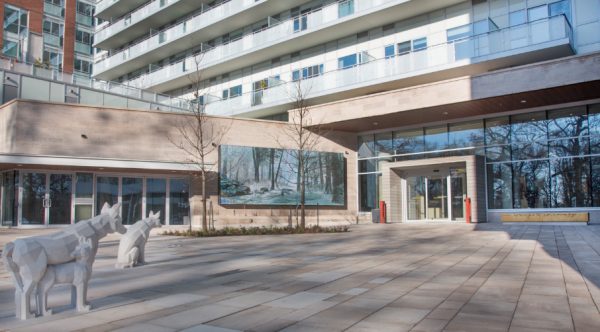
Q: You recently completed a permanent public art work We Are All Animals for a very different residential development – a high-rise residential tower opposite High Park. How does this work respond to its domestic context and the context of the nearby park? How does the piece create and animate a shared public space for the multiple residents?
EF: When Tamira and I first moved back to Toronto after living in Palestine, we moved into an apartment across the street from High Park. It was a great experience and the proximity allowed us to explore the Park’s many hidden corners. We therefore had a relationship to the park and felt strongly that any artwork we put close to the park had to acknowledge the urban nature around it. That was our starting point. Secondly, we thought about how public art in Toronto really needs to reflect the massive technological shifts in our world and as artists working in film, installation and with screens, we felt it was important to have a conversation that integrated technology. This was a risk that Daniels, the developer, decided was well worth taking in order to be committed to the wider current conversation.
We collaborated with a group of students from the OCADU Digital Futures program and together we thought about how both residents and the public would use the space -— it has a public dimension in the sense that it includes a large courtyard that opens to the street. We call the screen element of the work a “landscape tableau” because while it engages technology, it does so from the vantage point of wanting to slow down our current way of seeing. Both residents and members of the public can sit and simply look at the landscape as it shifts and changes — it is meditative but also provides different moments all day everyday — it doesn’t repeat; it functions as a real-time environment. The tableau is modelled in gaming software and changes with the time of day, the weather, animals come and go etc. It is a video game you can’t play essentially.
Additionally, there are two stone coyotes as there are indeed coyotes in the park although they are rarely ever-seen. The coyotes are part and parcel of how we have come to live together in urban spaces and our current relationship to nature. Our coyotes were carved from limestone by fairly traditional stone carvers in Toronto (Traditional Cut Stone) but we modelled and designed them out of polygons – we wanted them to live between the digital and natural world, did they come from across the street, from the park or did they emerge from the screen? We Are All Animals seeks to engage us all in a variety of conversations about our relationship to nature and technological change – we wanted to do this in a language that is current and speaks to a larger public.
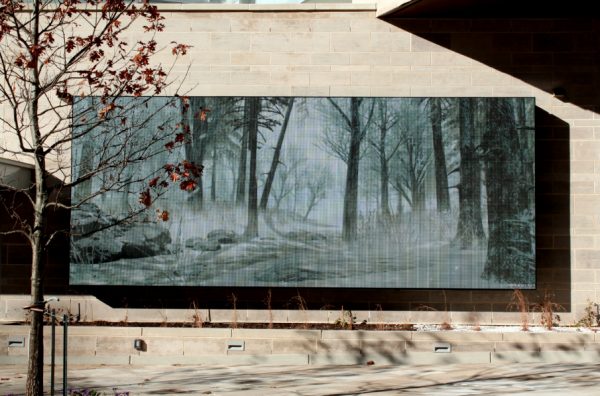
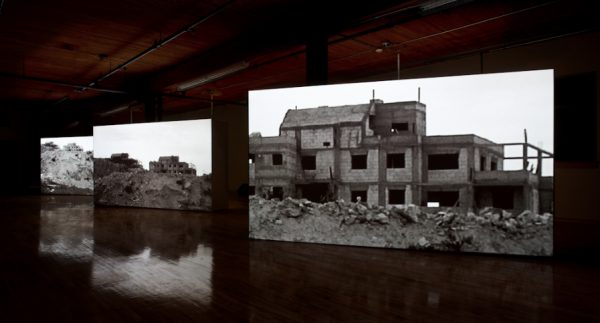
Q: Your immersive six-channel video installation Road Movie (2011) is currently on view in Limerick for the Irish Biennale. It’s a slow and engrossing work that demands attention. Has working in Palestine, and elsewhere, changed how you see public space in Toronto?
EF: We’ve shown Road Movie in many different spaces – Berlin, Winnipeg. Ottawa, Toronto and now in Limerick – and it continues to evoke different responses in each based on the varying political climates and locations. In each space we get to experience the work anew, because it’s so site specific.
TS: The idea of public space in Palestine is really interesting, because there isn’t really any. It’s a militarized space, and in a way, the way to see Palestine is through the roads. It’s a place through which you keep moving, because the second you stop you’re under scrutiny, being asked why you are here. Where are you from? Where are you going? There you are like a shark…it is a very strange thing. You can’t simply wander out into the landscape and explore. You’re not allowed. It’s a country carved into zones by political and military decisions.
There’s a beautiful book by Palestinian author Raja Shehadeh that talks about the tradition of walking the land, and how his attempts to do so are thwarted by various settlements and rules, and how difficult it now is.
EF: In short, our time in Palestine has taught us a great deal about how we understand land, space, public, private, and militarized zones. Reflecting on the recent Pride Parade and the explosion of debate over Black Lives Matters actions, I am reminded how important protest is and its relationship to walking and public/private space. Tamira and I marched in the front of the parade with Salah Bachir, who was one of the Grand Marshall’s – his message was about being a queer Arab and a solidarity march for the victims of the Orlando shootings. Because we were at the front, we missed the action and only learnt about it after. But I believe Black Lives Matter was saying something very clear both by marching and then by sitting down in the middle of it – a traditional and powerful way of peaceful protest. Pride has always been a very political expression and I think this hysteria that has resulted is racist, erasing the history of Black Queer lives that have been as much a part of the movement as white or other queer bodies. Walking as protest is at the heart of many a movement for social justice and BLM TO is asking very important questions about Black movement in public space — the freedom to move in public without being carded or checked designating you as “other,” just as we saw in Palestine and Israel.
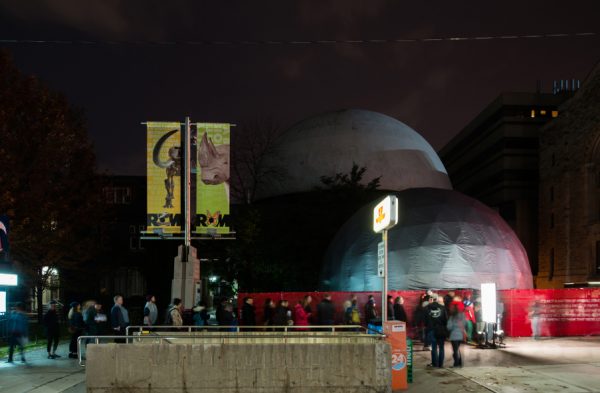
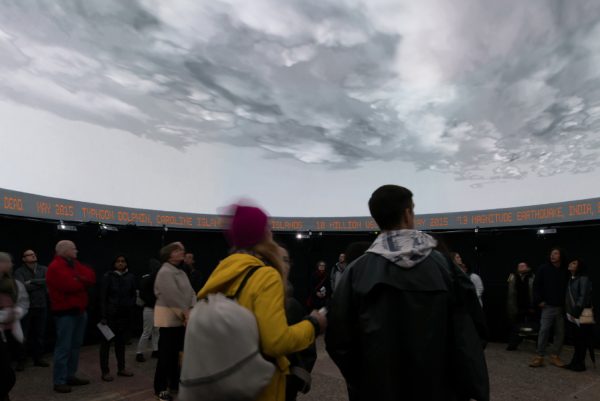
Q: Your practice is often described as being politicized. But do you think of your work as being explicitly political? I think of last year’s project for Nuit Blanche, the very poetic and meditative Zero Hour or your many architectural projects. Does engaging with other people – be it one or thousands – make something political in your minds?
TS: I don’t think we’ve ever put ourselves forward as being determinedly political. I’m not afraid of the term, and our work naturally engages with the world. I think our work is about how we see the world. We don’t set out to “do” politics.
EF: I am an expressly political person, and I grew up with it at the forefront of Jewish life and values (of a certain time if I may add). Similarly, Tamira comes from a Mennonite family where social justice was emphasized. Naturally these ethics are reflected in our personalities and our work. I think there is a need in the contemporary art world however to demarcate or even estrange political art as though it somehow doesn’t belong. But I wouldn’t place meditative and poetic in opposition to political. The poetic is often the way into the political — I think it was Eileen Myles who recently stated how “the poets are needed again.”
TS: I often feel like just embracing the term. There is a point where the naval gazing gets too much. But Elle’s more of an activist than I am. I am interested in living in the world and commenting on it.
Q: What are your favourite public spaces?
TS: In Ramallah Palestine, there is a public square that is remarkable. It’s called Al-Manara Square and it’s full of cars. Cars drive in a roundabout surrounding 4 statues of lions. I don’t know about another city that operates like this, where this is such a defined locus. Everyone meets there for everything – to protest, for news, to socialize. Not a traditional piazza full of cafes – it’s a very active, contemporary public space. The urban fabric of Kathmandu is also extremely interesting – all based around a courtyard system. Streets are even formed from private courtyards that slowly extend outward becoming larger semi-public spaces. As a city, it’s an amazing network of public and private courtyard spaces.
EF: Like too many cities today, Toronto doesn’t have much public space – Nathan Philips Sq for instance is one of our last large public arenas. Of course parks are public spaces but they are more leisure spaces and even there the control is so evident. We’ve been working on a number of public art projects in Toronto and we’ve noticed how everything is so over-programmed here, with so many competing interests – the anxiety to be programmed in our city is remarkable – we need to think of space as form (not something that needs to be filled necessarily).
TS: I have to make the point that I think there is a difference between effective and beautiful public spaces. Unfortunately, I would argue that the most effective ones are the private commercial ones, which are the shopping malls of the world. I would argue that spaces like the Eaton’s Centre has become our natural gathering place because we live in a capitalist world. It may not be our ideal public space, where people might come together around the free flow of ideas and people, but sadly it is where we come together — around shopping. I think that is the reality of public gatherings.
Q: The Bruce Trail project is set for 2017. What else are you excited about in the coming months?
TS: We are excited to be developing a more fulsome notion of integrated public art. We see across the city the schism between public spaces that receive art versus places that are designed for art, and want to change that. We are currently working with an architecture firm to develop an integrated plan for Moss Park. We were asked to come on as members of the design team, to think about integrating art into the project from the very beginning, involved in the use of building components and materials. Public artists, even now when the term “integrated art” is all the rage, are all too often seen as decorators – rather than as conceptual thinkers.
EF: One of our battle grounds as artists and as a city – is how art has been an afterthought. So in addition to our ongoing art practice that happens inside gallery spaces, we are very excited about developing and challenging the very notion of a public art practice.
The Artful City is a bi-weekly blog series exploring the evolution of public art and its role in the transformation of Toronto, both the city fabric and the community it houses. For more information about The Artful City visit: www.theartfulcity.org

